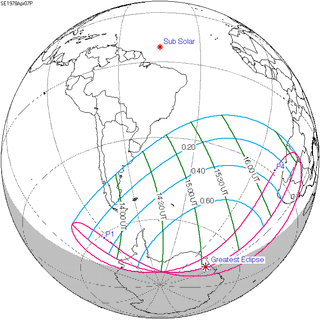
KNOWPIA
WELCOME TO KNOWPIA
Summary
A partial solar eclipse occurred at the Moon's descending node of the orbit on Friday, April 7, 1978. A solar eclipse occurs when the Moon passes between Earth and the Sun, thereby totally or partly obscuring the image of the Sun for a viewer on Earth. A partial solar eclipse occurs in the polar regions of the Earth when the center of the Moon's shadow misses the Earth.
| Solar eclipse of April 7, 1978 | |
|---|---|
 Map | |
| Type of eclipse | |
| Nature | Partial |
| Gamma | −1.1081 |
| Magnitude | 0.7883 |
| Maximum eclipse | |
| Coordinates | 71°54′S 23°18′E / 71.9°S 23.3°E |
| Times (UTC) | |
| Greatest eclipse | 15:03:47 |
| References | |
| Saros | 148 (19 of 75) |
| Catalog # (SE5000) | 9460 |
Related eclipses edit
Eclipses in 1978 edit
- A total lunar eclipse on Friday, 24 March 1978.
- A partial solar eclipse on Friday, 7 April 1978.
- A total lunar eclipse on Saturday, 16 September 1978.
- A partial solar eclipse on Monday, 2 October 1978.
Solar eclipses of 1975–1978 edit
There were 8 solar eclipses (at 6 month intervals) between May 11, 1975 and October 2, 1978.
| Solar eclipse series sets from 1975 to 1978 | ||||||
|---|---|---|---|---|---|---|
| Descending node | Ascending node | |||||
| Saros | Map | Gamma | Saros | Map | Gamma | |
| 118 | 1975 May 11 Partial |
1.06472 | 123 | 1975 November 3 Partial |
−1.02475 | |
| 128 | 1976 April 29 Annular |
0.33783 | 133 | 1976 October 23 Total |
−0.32699 | |
| 138 | 1977 April 18 Annular |
−0.39903 | 143 | 1977 October 12 Total |
0.38363 | |
| 148 | 1978 April 7Partial −1.10812 153 1978 October 2 Partial |
1.16164 | ||||
Metonic series edit
The metonic series repeats eclipses every 19 years (6939.69 days), lasting about 5 cycles. Eclipses occur in nearly the same calendar date. In addition, the octon subseries repeats 1/5 of that or every 3.8 years (1387.94 days).
| 22 eclipse events, progressing from north to south between April 8, 1902, and August 31, 1989: | ||||
|---|---|---|---|---|
| April 7–8 | January 24–25 | November 12 | August 31-September 1 | June 19–20 |
| 108 | 114 | 116 | ||
| April 8, 1902 |
August 31, 1913 |
June 19, 1917 | ||
| 118 | 120 | 122 | 124 | 126 |
| April 8, 1921 |
January 24, 1925 |
November 12, 1928 |
August 31, 1932 |
June 19, 1936 |
| 128 | 130 | 132 | 134 | 136 |
| April 7, 1940 |
January 25, 1944 |
November 12, 1947 |
September 1, 1951 |
June 20, 1955 |
| 138 | 140 | 142 | 144 | 146 |
| April 8, 1959 |
January 25, 1963 |
November 12, 1966 |
August 31, 1970 |
June 20, 1974 |
| 148 | 150 | 152 | 154 | |
| April 7, 1978 |
January 25, 1982 |
November 12, 1985 |
August 31, 1989 | |
References edit
External links edit
- Earth visibility chart and eclipse statistics Eclipse Predictions by Fred Espenak, NASA/GSFC
- Google interactive map
- Besselian elements


